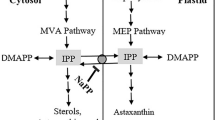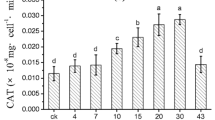Abstract
In this study, Chlorella vulgaris treated with static magnetic field (SMF) was investigated in terms of the algal density, biomass, extracellular polysaccharide content and distribution, percentage of algal aggregation, total protein content, enzyme activity, malondialdehyde content, and nutrient removal. The algal density and biomass under 800 G SMF were highest on the 16th day and were 29.02% and 35.67% greater than the control group (0 G group), respectively. Soluble EPS decreased with an increase in magnetic field strength, while bound EPS exhibited an opposite trend. Algal aggregation occurred in all treatment groups, with the aggregation percentage in the high magnetic field-treated groups being lower than that in the control group. Total protein content of the 800 G group was the lowest at 1.13 μg (106 cells)-1 and the enzyme activity of treated algae was higher than that of the control group. SMF affected the growth and reproduction of C. vulgaris by affecting the antioxidant response.








Similar content being viewed by others
References
Adav S, Lin J, Yang Z, Whiteley C, Lee D, Peng X, Zhang Z (2010) Stereological assessment of extracellular polymeric substances, exo-enzymes, and specific bacterial strains in bioaggregates using fluorescence experiments. Biotechnol Adv 28:255–280
Chen M, Lee D, Tay J, Show K (2007) Staining extracellular polymeric substances and cells in bioaggregates. Appl Microbiol Biotechnol 75:467–474
Chiou Y, Hsieh M, Yeh H (2010) Effect of algal extracellular polymer substances on UF membrane fouling. Desalination 250:648–652
De Philippis R, Vincenzini M (1998) Exocellular polysaccharides from cyanobacteria and their possible applications. FEMS Microbiol Rev 22:151–175
Dubois M, Gilles KA, Hamilton JK, Rebers PA, Smith F (1956) Colorimetric method for determination of sugars and related substances. Anal Chem 28:350–356
Esparza-Soto M, Westerhoff P (2003) Biosorption of humic and fulvic acids to live activated sludge biomass. Water Res 37:2301–2310
Ghasemi R, Ghaderian SM, Kramer U (2009) Accumulation of nickel in trichomes of a nickel hyperaccumulator plant, alyssum inflatum. Northeast Nat 16:81–92
Granum E, Kirkvold S, Myklestad SM (2002) Cellular and extracellular production of carbohydrates and amino acids by the marine diatom Skeletonema costatum: diel variations and effects of N depletion. Mar Ecol Prog Ser 242:83–94
Guerrini F, Cangini M, Boni L, Trost P, Pistocchi R (2000) Metabolic responses of the diatom Achnanthes brevipes (Bacillariophyceae) to nutrient limitation. J Phycol 36:882–890
Halliwell B, Gutteridge JMC (1992) Comments on review of free-radicals in biology and medicine. Free Radic Biol Med 12:93–95
Han S, Jin W, Chen Y, Tu R, Abomohra AE (2016) Enhancement of lipid production of Chlorella pyrenoidosa cultivated in municipal wastewater by magnetic treatment. Appl Biochem Biotechnol 180:1043–1055
Hinson RK, Kocher WM (1996) Model for effective diffusivities in aerobic biofilms. J Environ Eng 122:1023–1030
Hirano M, Ohta A, Abe K (1998) Magnetic field effects on photosynthesis and growth of the cyanobacterium Spirulina platensis. J Ferment Bioeng 86:313–316
Hsieh K, Murgel G, Lion L, Shuler M (1994) Interactions of microbial biofilms with toxic trace metals: 1. Observation and modeling of cell growth, attachment, and production of extracellular polymer. Biotechnol Bioeng 44:219–231
Ibelings B, Mur L, Walsby A (1991) Diurnal changes in buoyancy and vertical distribution in populations of Microcystis in two shallow lakes. J Plankton Res 13:419–436
Katz E, Lioubashevski O, Willner I (2005) Magnetic field effects on bioelectrocatalytic reactions of surface-confined enzyme systems: enhanced performance of biofuel cells. J Am Chem Soc 127:3979–3988
Kaur G, Alam S, Jabbar Z, Javed K, Athar M (2006) Evaluation of antioxidant activity of Cassia siamea flowers. J Ethnopharmacol 108:340–348
Kessel M, Eloff J (1975) The ultrastructure and development of the colonial sheath of Microcystis marginata. Arch Microbiol 106:209–214
Lancelot C, Mathot S, Owens NJP (1986) Modeling protein synthesis, a step to an accurate estimate of net primary production: Phaeocystis pouchetii colonies in Belgian coastal waters. Mar Ecol Prog Ser 32:193–202
Lee S, Kim S, Kim M, Lim K, Jung Y (2014) The effect of hydraulic characteristics on algal bloom in an artificial seawater canal: a case study in Songdo City, South Korea. Water 6:399–413
Li YG, Gao KS (2004) Photosynthetic physiology and growth as a function of colony size in the cyanobacterium Nostoc sphaeroides. Eur J Phycol 39:9–15
Li ZY, Guo SY, Li L, Cai MY (2007) Effects of electromagnetic field on the batch cultivation and nutritional composition of Spirulina platensis in an air-lift photobioreactor. Bioresour Technol 98:700–705
Li M, Zhu W, Gao L, Lu L (2013) Changes in extracellular polysaccharide content and morphology of Microcystis aeruginosa at different specific growth rates. J Appl Phycol 25:1023–1030
Liang W, Qu J, Chen L (2004) Algal inactivation and removal by pulsed magnetic field with varying frequency. Environ Sci 25:38–42
Liu W (2006) Research on the effect of magnetic field on the growth of algae. Water Purif Technol 25:19–21
Mallmann W, Buswell A, Gilcreas F, McCrady M, Nichols M, Olson T, Parr L, Tripp J (1945) Report of the standard methods committee on examination of water and sewage. Am J Public Health Nations Health 35:957–958
Markou G, Nerantzis E (2013) Microalgae for high-value compounds and biofuels production: a review with focus on cultivation under stress conditions. Biotechnol Adv 31:1532–1542
Mata TM, Martins AA, Caetano NS (2010) Microalgae for biodiesel production and other applications: a review. Renew Sust Energ Rev 14:217–232
Matsumoto T, Yamamura H, Hayakawa J, Watanabe Y, Harayama S (2014) Influence of extracellular polysaccharides (EPS) produced by two different green unicellular algae on membrane filtration in an algae-based biofuel production process. Water Sci Technol 69:1919–1925
Newman J, Watson R (1999) Preliminary observations on the control of algal growth by magnetic treatment of water. Hydrobiologia 415:319–322
Nielsen P, Jahn A, Palmgren R (1997) Conceptual model for production and composition of exopolymers in biofilms. Water Sci Technol 36:11–19
Plude J, Parker D, Schommer O, Timmerman R, Hagstrom S, Joers J, Hnasko R (1991) Chemical characterization of polysaccharide from the slime layer of the cyanobacterium Microcystis flos-aquae C3-40. Appl Environ Microbiol 57:1696–1700
Reiter RJ (1998) Melatonin in the context of the reported bioeffects of environmental electromagnetic fields. Bioelectrochem Bioenerg 47:135–142
Reynolds CS (2007) Variability in the provision and function of mucilage in phytoplankton: facultative responses to the environment. Hydrobiologia 578:37–45
Reynolds CS, Oliver RL, Walsby AE (1987) Cyanobacterial dominance: the role of buoyancy regulation in dynamic lake environments. N Z J Mar Freshw Res 21:379–390
Rippka R, Deruelles J, Waterbury JB, Herdman M, Stanier RY (1979) Generic assignments, strain histories and properties of pure cultures of cyanobacteria. J Gen Microbiol 111:1–61
Rugnini L, Costa G, Congestri R, Antonaroli S, Sanita di Toppi L, Bruno L (2018) Phosphorus and metal removal combined with lipid production by the green microalga Desmodesmus sp.: an integrated approach. Plant Physiol Biochem 125:45–51
Schenck J (1996) The role of magnetic susceptibility in magnetic resonance imaging: MRI magnetic compatibility of the first and second kinds. Med Phys 23:815–850
Schenk PM, Thomas-Hall SR, Stephens E, Marx UC, Mussgnug JH, Posten C, Kruse O, Hankamer B (2008) Second generation biofuels: high-efficiency microalgae for biodiesel production. Bioenergy Res 1:20–43
Sheng GP, Yu HQ, Li XY (2010) Extracellular polymeric substances (EPS) of microbial aggregates in biological wastewater treatment systems: a review. Biotechnol Adv 28:882–894
Small DP, Huner NP, Wan W (2012) Effect of static magnetic fields on the growth, photosynthesis and ultrastructure of Chlorella kessleri microalgae. Bioelectromagnetics 33:298–308
Staudt C, Horn H, Hempel D, Neu T (2004) Volumetric measurements of bacterial cells and extracellular polymeric substance glycoconjugates in biofilms. Biotechnol Bioeng 88:585–592
Sun XJ, Qin BQ, Zhu GW (2007) Release of colloidal phosphorus, nitrogen and organic carbon in the course of dying and decomposing of cyanobacteria. Environ Sci 27:341–345
Sutherland IW (2001) Biofilm exopolysaccharides: a strong and sticky framework. Microbiology-UK 147:3–9
Thornton D (2002) Diatom aggregation in the sea: mechanisms and ecological implications. Eur J Phycol 37:149–161
Tu R, Jin W, Xi T, Yang Q, Han SF, Abomohra Ael F (2015) Effect of static magnetic field on the oxygen production of Scenedesmus obliquus cultivated in municipal wastewater. Water Res 86:132–138
Vílchez C, Garbayo I, Lobato MV, Vega J (1997) Microalgae-mediated chemicals production and wastes removal. Enzym Microb Technol 20:562–572
Wang HY, Zeng XB, Guo SY (2006) Growth of Chlorella vulgaris under different magnetic treatments. Progr Mod Biomed 6:106–109
Wang HY, Zeng XB, Guo SY, Li ZT (2008) Effects of magnetic field on the antioxidant defense system of recirculation-cultured Chlorella vulgaris. Bioelectromagnetics 29:39–46
Wang Z, Zhang J, Li E, Zhang L, Wang X, Song L (2017) Combined toxic effects and mechanisms of microsystin-LR and copper on Vallisneria natans (Lour.) Hara seedlings. J Hazard Mater 328:108–116
Widjaja A, Chien C, Ju Y (2009) Study of increasing lipid production from fresh water microalgae Chlorella vulgaris. J Taiwan Inst Chem Eng 40:13–20
Wu ZX, Song LR (2008) Physiological comparison between colonial and unicellular forms of Microcystis aeruginosa Kutz. (Cyanobacteria). Phycologia 47:98–104
Xu H, Yan Z, Cai H, Yu G, Yang L, Jiang H (2013a) Heterogeneity in metal binding by individual fluorescent components in a eutrophic algae-rich lake. Ecotoxicol Environ Saf 98:266–272
Xu H, Yu G, Jiang H (2013b) Investigation on extracellular polymeric substances from mucilaginous cyanobacterial blooms in eutrophic freshwater lakes. Chemosphere 93:75–81
Yang Z, Kong F, Shi X, Min Z, Cao H (2008) Changes in the morphology and polysaccharide content of Microcystis aeruginosa (cyanobacteria) during flagellate grazing. J Phycol 44:716–720
Yang Z, Liu Y, Ge J, Wang W, Chen Y, Montagnes D (2010) Aggregate formation and polysaccharide content of Chlorella pyrenoidosa Chick (Chlorophyta) in response to simulated nutrient stress. BioresourTechnol 101:8336–8341
Zhang X, Bishop PL (2003) Biodegradability of biofilm extracellular polymeric substances. Chemosphere 50:63–69
Funding
The study was supported by the National Science Foundation of China (51308127) and the Major Science and Technology Program for Water Pollution Control and Treatment (2012ZX07103-004).
Author information
Authors and Affiliations
Corresponding author
Additional information
Publisher’s note
Springer Nature remains neutral with regard to jurisdictional claims in published maps and institutional affiliations.
Rights and permissions
About this article
Cite this article
Luo, X., Zhang, H., Li, Q. et al. Effects of static magnetic field on Chlorella vulgaris: growth and extracellular polysaccharide (EPS) production. J Appl Phycol 32, 2819–2828 (2020). https://doi.org/10.1007/s10811-020-02164-7
Received:
Revised:
Accepted:
Published:
Issue Date:
DOI: https://doi.org/10.1007/s10811-020-02164-7




